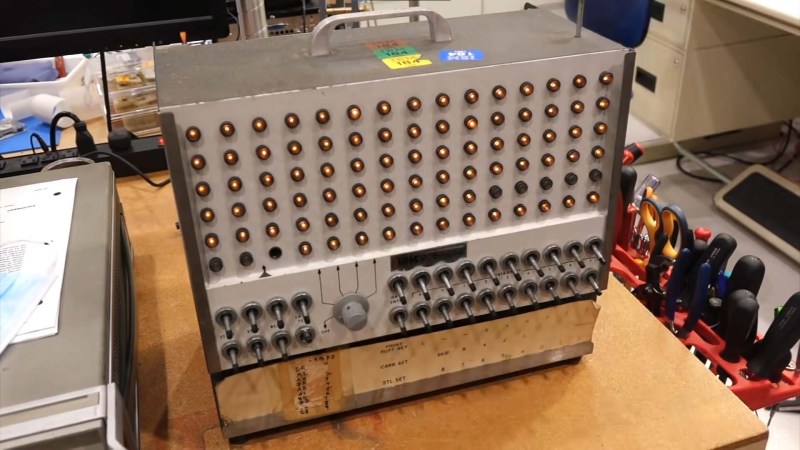By now, [CuriousMarc] and his team of volunteers are well versed in 1960s hardware restoration. So when a vintage IBM I/O Tester came into their possession, a full machine makeover was all but inevitable.
The I/O Tester dates from around 1965, which roughly coincides with the introduction of IBM’s lauded System/360 computer mainframe. In addition to the computer itself, business customers could order a variety of peripherals with their computing system. These included storage devices, printers, additional operator consoles, and so on. Since these peripherals shared the same I/O design, a portable hardware testing rig was a sensible design choice. One portable low-voltage tester could be paired with any number of IBM peripherals, doing away with the need to have unique debugging panels on every piece of computing hardware.
Fast forward to the present day, and the IBM I/O Tester looks positively antique with its blinkenlight lamp panel and switches. To use the tester, simply connect up one (or both) of its chunky 104-pin connectors to your IBM peripheral of choice, insert the accompanying paper overlay, and voilà. Operators could then observe the status of the many lamps to evaluate the inner digital workings of the connected peripheral. Depending on the connected hardware, the tester could reveal the contents of data registers, printing status, disk and tape transfer status, and probably much more. The purpose of the tester’s ninety indicator lights is completely dependent on the attached peripheral, and the paired paper overlays are essential to comprehend their meaning.
After [Ken Shirriff] deciphered the documentation, it wasn’t long before the tester could be powered up using 24 VAC (normally supplied by the equipment being tested). Several burned out lamps were noted for replacement. The lamp assemblies required minor surgery due to a dubious design choice, and at least one of the toggle switches needed a new guide and a heavy dose of contact cleaner before it came back to life.
For the moment, [CuriousMarc] is using the blinkenlights panel as a surprisingly striking retro clock. With a literal truckload of vintage IBM hardware sitting in his storage, it’ll be exciting to see whether this restored tester will be pulled back into operational service someday. Readers should also check out our coverage of his previous major project, restoring an Apollo Guidance Computer.
















Oooo! Luv it!
(Video and tester)
I used one of these many times troubleshooting 2821 control units that drove the 1403 printers and 2540 reader/punch.
Wow great find, great fixes and great new peripheral!
Thank goodness it ended up with someone who did not want to just gut it and stick an arduino inside to turn it into a clock.
dont be silly, it would have been an esp or a pi
I thought that timing was what the 555 was good at? *ducks*
I’ve used the tester on the 2821 for 2540 (card reader/punch) and 1403 (line printer). Still have manuals for them somewhere, have been considering feeding the fireplace with them.
The 2821 had 2 core memory arrays. One for the data to be printed, the other for the sequence of type slugs on the print train. When the data to be printed lined up with the timing on the print train, the hammer was fired. This allowed more than one hammer to fire at the same time. 1403 printed 1100 lines/minute. And the carriage was driven by hydraulics.
You may consider donating these irreplaceable manuals to the Computer History Museum ( CHM ), these would be greatly appreciated and kept for posterity.
If you decide to donate, I can provide you with address.
I wouldn’t think these manuals would be too rare, the machines were all over.
I went to the CHM site, to look and see if they had a request page or similar. The donate link seems only to be concerned with money. And navigating the site is a pain. The scroll bar kept disappearing.
So, I have to wonder if they are really worth the effort. Are these manuals made available to the public?
Are there alternate places that might find these useful?
Amazon?
Is [Marc] associated with CHM? I don’t know. But, if he isn’t, he might be interested in the manuals. Contact him through his YouTube link?
Try archive.org
We scanned about 6Tb of manuals out of our computer collection at hack42 for them and sended just the images of separate pages. They have a toolchain to condence them into pdf, epub and other formats.
I worked as a IBM Large Systems Customer Engineer from 1979 thru 1989. We used these testers attached to 2821 controllers. The 2821 was connected to 2540 reader punch card equipment and 1403 printers. I think the 1403 printer was originally announced with the 1401 processor which preceded System 360. The 2821 was a fairly reliable device except for the reed relays. https://en.wikipedia.org/wiki/IBM_2821_Control_Unit